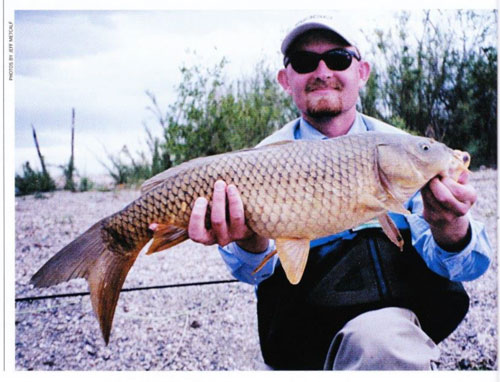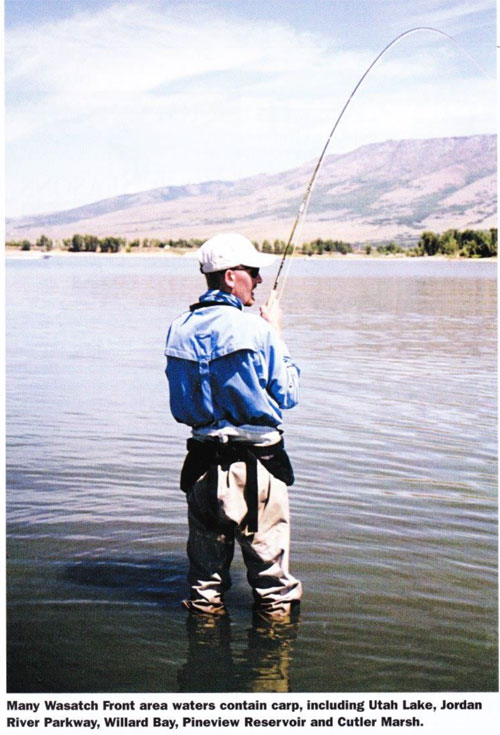 By Jeff Metcalf
By Jeff Metcalf
Utah Outdoors - June 2002
LOOK, I'M TAKING A big risk here. Really big. It's like I’m in a 12-step Fly Fishing Anonymous program. It’s my first meeting and I'm nervous. I should have come here a long time ago, before it was too late, but i was weak. I still might be. I'm surrounded by a group of trout addicts; men and women who have forsaken family, friends, work and other important adult stuff in search of that perfect moment on a river. I understand the problem all too well.
I can imagine what it must look like in the Fishaholic Anonymous meeting room. I walk in... I'm the new guy... there isn’t a story that has been told about the depths to which one can sink in the pursuit of trout that these folks haven’t heard. Not yet. But I think I Just might have one.
"Hello, my name is Jeff and I’ve recently begun fishing for carp."
My disclosure is a show-stopper, Slack-jawed addicts, hard-core veterans who think they have heard just about everything dealing with the degradation of the human spirit when it comes to fly fishing tales of woe are left stunned and speechless. Even for them, this is too much. I turn away. I am a leper. I am an untouchable.
The reality
Truly, the above scene is not too far fetched. Mention the idea that you’ve been fishing for carp and you get the "look" - followed by the "question." The look is one of those "You’re joking, aren’t you?" and the question is always the same: "Why would anyone in their right mind fish for carp?"
The truth is, fishing for carp is absolutely fantastic sport. I’m dead serious. Carp fishing is the poor man's bone fishing. One doesn’t have to fly halfway around the world at a rather steep price tag to cast to the noble carp. Carp are present in every state in the country in a variety of species. They are, for the most part, easily accessible and can be fished to using either nymphs or dry flies (the latter being the most difficult because carp normally feed on the bottom).
Debunking the myth
 In our fishing culture, carp carry the unfortunate mantle of being referred to as trash fish. What is ironic about this label is the very thing that should make us rethink the value of carp, both as a fishing resource and an environmentally enduring species of freshwater fish that can survive where trout simply can't: carp are tough and adaptable. They seem to have a more sophisticated sense of smell than trout, and they are considered more intelligent. Add the fact that carp usually feed on the bottom and it’s easy to see them as a noble adversary for anybody serious about hooking into a great sporting fish.
In our fishing culture, carp carry the unfortunate mantle of being referred to as trash fish. What is ironic about this label is the very thing that should make us rethink the value of carp, both as a fishing resource and an environmentally enduring species of freshwater fish that can survive where trout simply can't: carp are tough and adaptable. They seem to have a more sophisticated sense of smell than trout, and they are considered more intelligent. Add the fact that carp usually feed on the bottom and it’s easy to see them as a noble adversary for anybody serious about hooking into a great sporting fish.
Carp are revered by many European and Asian cultures; in some areas they are considered to be one of the finest freshwater combatants available to fishermen. Historically, carp were introduced to American waters by our ancestors who brought them here as a source of food. Stock ponds were created to breed carp and because they are so hardy and travel well, it was natural to spread them from state to state. Part of the rationale for introducing carp to American waters was to provide a viable food source for new immigrants passing from eastern to western territories.
Somehow over the years, we lost our respect for this prehistoric fish. Perhaps it is time to revisit the potential of carp as a legitimate sporting fish and an alternative to trout fishing when looking to get away from crowded waters.
Finding carp
Finding carp is not that difficult. Because they are very adaptable to a wide range of both water temperatures and habitat, they can he found every where from high lakes to city streams. Case in point: while writing an article for this magazine on urban fishing I hooked into my first carp directly across from the Cottonwood Mall in Holladay. l was drifting a small bead-head hare’s ear in a deep pool in search of trout when my line stopped dead still. Thinking I had perhaps hooked a log or some submerged foliage, I gave a tug. What happened next caught me quite by surprise. My line began moving away from me at a very steady speed. Nothing fancy, nothing frantic, just deep and strong. I thought of "Jaws." The tip of my 6-weight rod bent fully and the carp had no plans to give me an inch. I was losing ground. My line kept reeling off at a constant pace and I needed to turn the carp quickly or risk losing it. A careless attempt to bring the fish to the surface resulted in a "ping" of my line. Score one for the carp.
I snipped my leader down to about 3x and soon managed to hook into another carp. Twenty minutes later I landed a common carp more than 20 inches long and weighing about 5 pounds. To this day I’m convinced the only reason I was able to beach the fish was because it had nowhere to run. In wide-open flats, I would soon learn, the story would be very different. Lance Egan of Fish Tech Outfitters has been fishing for carp for a couple of years. He gets it. There is no apology or hesitation in his voice when he talks about headhunting for the behemoths. Along with my good fishing partner, Dave Kempner, we headed off to fish the shallows of Pineview Reservoir. Egan offered some advice and gave us fair warning: "Carp are strong. They can strip you down to the backing in no time. The carp in Pineview are mirror carp, not as big as the one's you’ll find in Willard Bay, but plenty strong enough to give you a good run."
After arriving at Pineview, we headed out for the flat shallows to look for feeding carp. Egan pointed out that because carp subsist on plants, crustaceans and aquatic insects, we should look for weedy areas where we could spot and stalk individual carp. He instructed us to look for fins and tails, follow cruisers and try to place our flies directly in front of the carp. Then we should let the flies settle to the bottom and be prepared for anything.
Since carp are naturally spooky fish and come to the shallows because they can forage under the protection of cover, he admonished us to move slowly, watch our shadows and not splash around too much. Easier said than done.
Not unlike trout, once hooked, carp immediately head into the thickest cover to try to rub out or bust off the leader. Our fly for the day was a bead-headed, butt-ugly sparkling crystal chenille nymph in sizes 10-12. Under murky conditions it was sometimes visible, which because extremely important in making a successful set. Additionally, strike indicators are a necessity because carp don’t slam into a fly; they sip and vacuum and are adept at spitting out imposters in a split second. The take is very, very subtle.
Egan’s instinct and experience stalking carp has taught him that casting to a shoal of carp is less productive than casting to a single fish. In a shoal, there is greater opportunity for a sentry carp to sound the alarm of approaching predators.
I came to this same realization after I made one of my initial casts to a shoal of fish rooting for food in an extremely weedy stretch of water that disappeared into some deep, brackish backwater. My first cast didn’t seem to disturb any of the carp. I retrieved my fly and cast again. It was on a slow strip of my line where things went awry. The bead-head l was using snagged on some weeds. I gave a gentle tug but the fly was imbedded deeply into a root of some sort. A more stern pull jerked some of the weeds and that was all it took. Badda-boom! Off into the deep, leaving nothing but murky swirls for me to study.
By mid-morning we had hooked and landed approximately a dozen and a half mirror carp. Many more were hooked and snapped us off before we could turn them. With each strike there was a huge rush of Adrenalin followed by the simple question of whether these monsters cold be landed. As one might expect, the advantage was truly on the side of the carp.
They are, without question, powerful and exciting fish to attempt to land on a fly, certainly worth any angler’s attention. To relegate carp to a sub-category of trash fish is a mistake. In truth, we had a beautiful morning on Pineview Reservoir, stalking and fishing to carp, perhaps one or the most maligned and misunderstood species of fish available to anglers in this state.
So, on a spectacular Utah morning, the sun just beginning to rise over the mountains, Pineview Reservoir a glassy slick mirror of water, I easily imagined myself in Belize, casting to bonefish with the distinct promise of a wild ride should I hook up to a prehistoric carp.
We were not disappointed.
Where to go
Most Utah waters contain carp, from Lake Powell to Flaming Gorge to the Sevier River. Below we mention some of the better waters that are close to our population centers:
- Utah Lake - Take I-15 to exit 268 in Provo, and then go west to the state park.
- Jordan River Parkway - The river parallels I-15, to the west with several well-marked access points.
- Willard Bay - West of I-15, eight miles north of Ogden. Many good access points; stay in the shallows.
- Pineview Reservoir - Take I-15 to Ogden exit 347 and follow U-39 to the reservoir.
- Cutler Marsh - On the Bear River west of Logan.
What to use
Try 4-, 5- or 6-weight rod, Floating or sink-tip line, strike indicator, flies with bead heads or split shot.
Fly selection: Leech patterns, bead-head prince, hares ear, woolly bugger, bead-headed stonefly nymph, bead-headed Batman or San Juan worm, Sizes will vary from 6 to 18, depending on the fly.
